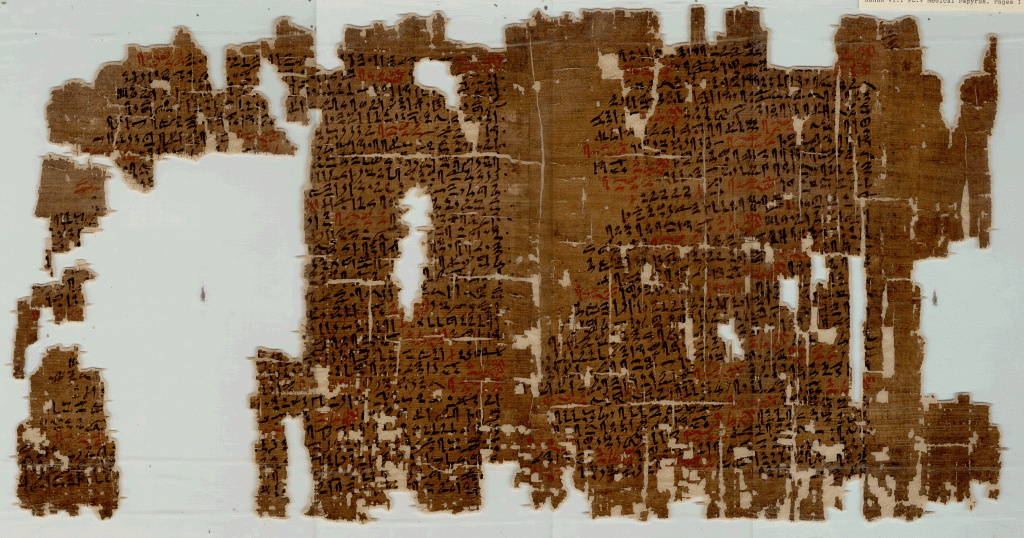Winner of the Fall 2017 StMU History Media Award for
Best Article in the Category of “Gender Studies”
Best Overall Research
For most of modern memory, the predominant belief was that sex was for procreation, and that pleasure was a sin.1 As a result, members of modern society tend to assume that contraception is a fairly recent practice. Yet, contrary to popular belief, many ancient societies believed in sex for pleasure. For instance, some of the earliest medical writings show contraception played a role in Egyptian society.2 Some question the efficacy of the contraceptive techniques as another method of suggesting that sex for pleasure was not historically possible. But there is little doubt that the reason for the Egyptians’ seeking effective contraception was to permit sex without the concern of procreation, hence sex solely for pleasure. Indeed, sources like the Kahun Papyrus show us that our ancient and pre-modern ancestors knew a good deal about reproduction and effective contraception—proving that Egyptian women had more control over their sexuality in ancient times than many woman have enjoyed since the rise of modern religions.3
The main source of historical evidence that contributes to this debate between contraception and infant mortality, and between magic and medicine, is the Kahun Gynecological Papyrus.4 The Kahun Papyrus was discovered by Petrie Flinders in 1889 in a small village called El-Lahun, one-hundred kilometers south-west of Cairo. It dates to 1850 B.C.E., and is the earliest record of ancient Egyptian medical practices. The papyrus is entirely gynecological in nature and is written in hieratic script, not hieroglyphs. It did not become legible until 1806 after the discovery of the Rosetta stone.5 It is divided into thirty-four sections, each dealing with a specific problem relating to gynecological disease, fertility, contraception, and pregnancy. Three of these fragments are prescriptions that relate specifically to preventing conception, all of which involve vaginal suppositories.6 When Flinders found the papyrus, it was badly damaged with small fragments of text missing.7 These missing fragments keep the debate alive as to how exactly some of these remedies were used.
However, despite the long-held belief among scholars that the relative stability of ancient populations was linked to a high infant mortality rate, there is significant evidence that shows that that was not the case.8 The Kahun Papyrus shows us that Egyptian medical practices were based in fact and knowledge, with only a sprinkling of the supernatural. In his book, Contraception and Abortion from the Ancient World to Renaissance, John Riddle, a leading expert of ancient pharmacology, makes the argument that population stability was not linked to high infant mortality rates. Instead, Riddle asserts that population control was due to the use of herbal contraceptives by women.9 The ancient world held much more knowledge of contraceptives than previously thought.10

The main treatments detailed in the papyrus were founded in Egyptians’ knowledge and observations of herbs, plants, minerals, and the effects these items in nature had on animals. The Egyptians noticed that when animals ate certain plants they failed to reproduce. They carried this observation over into their reproductive techniques. Ingredients listed in the contraceptive techniques include acacia gum, sour milk, crocodile dung, fiber, and honey.11 These ingredients were mixed into a pessary and inserted into the vagina by a swnw, or person who was skilled in the art of healing. The pessary would work to block the sperm from reaching a woman’s fallopian tubes and finding an egg to fertilize. When the method using sour milk was tested, the results showed that the enhancement of the acidic environment of the vagina with the introduction of sour milk establishes an effective spermicide, thus proving that the Egyptians did use medicinal techniques that were based on fact, not simply on fiction.12
The existence of contraceptive treatments reflected within the Kahun Papyrus combined with their demonstrated effectiveness leads to the extrapolation that population control was both a desired and achievable outcome for ancient Egyptians. If John Riddle’s theory that the Egyptians actively prevented pregnancy is correct—and the evidence suggests that it is—then we can conclude that sex was not only for reproduction, but for enjoyment.13 In her book Sexual Deviance and Society, Meredith G. F Worthen asserts that sexual imagery from more than 5,000 years ago has been credited to ancient Egyptian cultures. Although we may see these depictions as pornography, to ancient Egyptians they were just a part of sexual life.14 This could lead to the belief that ancient Egyptians were not exactly modest when it came to sexuality and sexual pleasure. To freely express their sexuality, effective contraceptives were a necessity.

Overall, the evidence directs us to the fact that Egyptians held knowledge about contraceptives and used them to prevent pregnancy. So why is the modern belief that contraceptives are a new invention, rather than several millennia old? The answer lies in the rise of Christianity. Before Christianity found its foothold as a highly influential religion, early humans often equated sexual and religious experiences. Christian hostility to sexuality built steadily in the early centuries of the religion. This hostility produced a new attitude of denunciation of women’s sexuality. Early Christians promoted the narrative that Jesus was not born from normal sexual activity, but from a virgin through immaculate conception. Once the religion gained traction, sexual misbehavior was not only seen as a danger to proper human values, but as an offense to God himself. The prevailing belief was that sex was only allowed in marriage and for reproduction. Christian missionaries eventually held enough influence over governments that they pushed them to add new secular penalties to violations of sexual regulations. Secular laws began to target the use of contraception or any other act preventing birth, in some cases the penalty for these acts was death. Over time, Christianity succeeded in chiseling away at “open” sexuality.15 Though modern society has begun to shed this belief, we still see vestiges of it linger in the way sexuality among woman is described. Women who enjoy sex face negative rebukes across the world. These hostile ideologies explain some scholars’ reluctance to accept the fact that ancient Egyptian women enjoyed sex and actively and effectively engaged in it without the outcome of pregnancy.
“Man has always had a desire to heal and control fertility.”16 This truth does not apply only in modern times as many think; the Kahun Papyrus shows that this desire goes all the way back to at least 1825 B.C.E. Yes, the Egyptians’ medical practices were influenced by religion, but we cannot discount their effective techniques simply because they imbibed those practices with the supernatural. Joshua Mark says that “most people would balk at the idea of visiting a doctor and having incantations muttered over them.”17 Yet, we have long had, and still have, very similar rituals in modern Christian society. Doctors will sometimes use their medical knowledge to treat patients, while also praying for or with them. The Kahun Papyrus can be evaluated the same way. We, as a society are reluctant to accept the fact that women are sexual beings, but the historical evidence proves that women have sought control over their sexual experiences since ancient times. That desire is not new to modern society. Steeped in religion though it may be, the papyrus proves our ancient ancestors developed effective techniques for contraception so they would be free to pursue their sexual desires without the fear of procreation.
- Peter N. Stearns, Sexuality in World History (Madison, NY: Routledge, 2009), 47. ↵
- Gary B. Ferngren, “Eve’s Herbs: A History of Contraception and Abortion in the West,” The New England Journal of Medicine 341, (1997): 1398. ↵
- John Riddle, Contraception and Abortion from the Ancient World to the Renaissance (Cambridge, MA: Harvard University Press, 1992), 67. ↵
- Stephen Quirke, Manuscript for the health of mother and child (London: University of London, 2002), 1-3. ↵
- Chinmoy K. Bose, “The el-Lahun gynecological papyrus,” Hekton International: A Journal of Medical Humanities 9, no.2 (2016), http://hekint.org/the-el-lahun-gynecological-papyrus/. ↵
- John Riddle, Contraception and Abortion from the Ancient World to the Renaissance (Cambridge, MA: Harvard University Press, 1992), 66. ↵
- Chinmoy K. Bose, “The el-Lahun gynecological papyrus,” Hekton International: A Journal of Medical Humanities 9, no.2 (2016), http://hekint.org/the-el-lahun-gynecological-papyrus/. ↵
- Gary B. Ferngren, “Eve’s Herbs: A History of Contraception and Abortion in the West,” The New England Journal of Medicine 341, (1997): 1398. ↵
- Gary B. Ferngren, “Eve’s Herbs: A History of Contraception and Abortion in the West,” The New England Journal of Medicine 341, (1997): 1398. ↵
- Ronit Haimov-Kochman, Arye Hurwitz, Yael Sciaky-Tamir, “Reproduction concepts and practices in ancient Egypt mirrored by modern medicine,” European Journal of Obstetrics and Gynecology and Reproductive Biology 123, no. 1 (2005): 3-8. ↵
- Lesley Smith, “The Kahun Gaynaecological Papyrus: ancient Egyptian medicine,” Journal of Family Planning and Reproductive Health Care 37, no.1 (2010): 54–55. ↵
- Ronit Haimov-Kochman, Arye Hurwitz, Yael Sciaky-Tamir, “Reproduction concepts and practices in ancient Egypt mirrored by modern medicine,” European Journal of Obstetrics and Gynecology and Reproductive Biology 123, no. 1 (2005): 4-5. ↵
- John Riddle, Contraception and Abortion from the Ancient World to the Renaissance (Cambridge, MA: Harvard University Press, 1992), 70. ↵
- Meredith G. F. Worthen, Sexual Deviance and Society: A sociological examination (New York: Routledge, 2016), 140. ↵
- Peter N. Stearns, Sexuality In World History (Madison, NY: Routledge, 2009), 43-48. ↵
- Lesley Smith, “The Kahun Gaynaecological Papyrus: ancient Egyptian medicine,” Journal of Family Planning and Reproductive Health Care 37, no.1 (2010): 54–55. ↵
- Ancient History Encyclopedia, February 2017, s.v “Ancient Egyptian Medical Texts,” Joshua J. Mark. ↵



146 comments
Thomas Fraire
This article was very interesting and I had no prior knowledge about this topic, I honestly clicked on the article because of the title it sounded really interesting and different than anything I had read. It is cool to see this feminist movement kind of start and it shows that this is a fight that has been going on forever and women continue to make small strives and it cool to see how we have progressed in society.
Liam Gillooly
How fascinating that the practice of contraception has been understood since antiquity. I am also amazed to learn how sexually liberated Egyptian women were compared to their classical counterparts. I have never heard about the Kahun Papyrus, likely due to the fundamentalist nature of our educational system. I like how the Egyptians would watch animals to learn how to better adapt their own lives. I don’t know if I would like my own partner to pull out a jar of crocodile feces, but if it worked for them…
Rebekah Esquivel
I really enjoyed reading this article. In society today, there are many controversies over the use of contraception and also a variety of contraceptions that are able to be used. I was very interested in this as Egyptians so long ago started to use contraception in order to use sex for pleasure without the risk of getting pregnant. I find it so fascinating how they used natural remedies as a form of contraception such as plants and sour milk based on what they saw go on with animals. This was a super interesting article and great to read.
Erin Vento
I love how this article is a historical study on sex and how Egyptians used forms of birth control and it reflects arguments we continue to have to this day. Its funny to see how Egyptians may have a more modern view of sexuality and just sex overall than some people do today; of course, we know a little more than we did then and no woman would put sour milk up there, but it’s crazy to think how contraceptives we not the cause for arguments then.
Benjamin Voy
What a great article this was. It isn’t often you read an article as interesting as this. I never would have thought that contraception was even a thing back then. It was so interesting to learn about how they did it as well. After just taking their time to notice why animals could not reproduce, they found a way to help them as well, which is incredible to me. An extremely well written article that flows very well together too.
Ernie Sano
What an interesting article. The connections made by the author were astounding and very reasonable. I am glad that your article pointed out the idea that society is against those who choose to have sex for pleasure. I have always been an advocate for freedom of thoughts and ideas, and I enjoy seeing an article that takes this concept and allows it to flourish by providing information that shows the thought process behind other people’s opinions.
Alejandra Chavez
This has to be my favorite article that I have read thus far. I thank you for understanding how it is because of religion, women were undermined and shamed for their sexual expression and practices. I applaud you for the way you were able to intelligently explain how women having sexual liberation is a concept that isn’t new, but has only been hushed due to sexist-controlling views. Very well written article. I’m very appreciative of it.
Maria Callejas
First of all, what an interesting article! Again, this was totally new knowledge for me, it is astounding to see how gynecology was a topic of interest during those times. This article definitely puts things into perspective, as it seems that women have had little control over their bodies even during “Papyrus” times. This clearly reflects the scrutiny women go through today. Great job!
Dayna Valdez
I absolutely loved reading this article. It isn’t often you read an article like this. I never would have thought that contraception was even a thing so far back in time. It was very interesting to learn about how they did so as well. After just taking their time to notice why animals could not reproduce, they found a way to help them as well, which is incredible to me.
Erik Shannon
Gee wiz! What a article! This article was so interesting especially reflecting on today’s society. Throughout our culture we say and brag how we are progressing as a society but there is still double standards put on women. Even in ancient times women have been trying to take control of their sexuality and life but are constantly pushed back. This article is great and would recommend it to anyone.